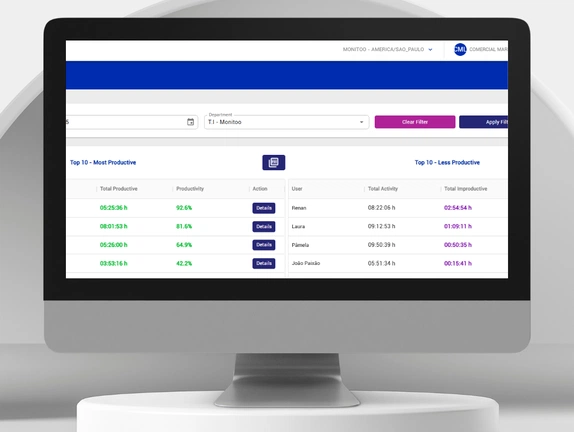Productivity , Efficiency
06 de October de 2025 - 20h10m
ShareHave you ever looked at a report full of acronyms and numbers and thought, “What does this actually mean?”
If so, you’re not alone.
Many managers face the same challenge: interpreting productivity and performance indicators that seem more like a secret code than a decision-making tool.
But the truth is simple — the right numbers reveal what’s driving (or holding back) your team’s results.
These acronyms — KPI, OKR, ROI, SLA, and others — are not just corporate buzzwords.
They’re practical tools that help you clearly visualize team performance, identify bottlenecks, and create data-driven strategies.
In this complete guide, you’ll discover:
Ready to decode the language of high performance?
Let’s get started.
Before memorizing acronyms, it’s essential to understand why they exist.
A productivity indicator is an objective way to measure whether the work of a person, team, or company is producing the expected results within available time and resources.
In other words, it’s the thermometer of efficiency.
However, indicators are not always written out in full.
That’s why the world of management uses standardized acronyms to translate complex concepts into simple, universal, and comparable metrics.
These acronyms allow managers to:
Once you understand the meaning behind each acronym, every number gains context — and that’s when strategic decisions begin.
A common mistake is turning productivity analysis into a mountain of spreadsheets.
The secret lies in using fewer metrics — but the right ones.
Here’s how:
That’s where technology comes in.
Tools like Monitoo automate productivity data collection and analysis, saving time and avoiding human error.
You get automatically updated reports, charts, and indicators — so you can focus on acting, not just measuring.
Here are the 10 key acronyms every manager should know — with definitions, formulas, examples, and practical tips.
KPI — Key Performance Indicator
What it is:
The main metric that shows whether a goal is being achieved.
It can represent productivity, quality, delivery, revenue, time, etc.
Formula:
Depends on the objective.
For example:
Productivity = (Productive Hours ÷ Total Hours) × 100
Example:
If your team worked 120 productive hours out of 160 total, your efficiency KPI is 75%.
How to use:
Define 3–5 main KPIs per department and track them weekly.
Avoid excessive metrics — efficient management is lean management.
OKR — Objectives and Key Results
What it is:
A goal-setting framework created by Intel and popularized by Google.
The O defines where you want to go, and the KR defines how you’ll know you’ve arrived.
Example:
Objective: Increase the productivity of the sales team.
Key Results:
How to use:
Review and update OKRs quarterly.
Use tools like Monitoo to monitor if the key results are being reflected in the team’s actual performance.
SLA — Service Level Agreement
What it is:
An agreement that defines the expected time and quality for a delivery or service.
Common in support, customer service, and operations.
Formula:
SLA Achieved (%) = (Requests Resolved Within Deadline ÷ Total Requests) × 100
Example:
If 90 out of 100 tickets were resolved within the expected timeframe, your SLA is 90%.
How to use:
Track this indicator to ensure your team is meeting demand efficiently.
Monitoo can measure active vs. idle time during support tasks, helping you achieve SLA goals.
OEE — Overall Equipment Effectiveness
What it is:
Measures the efficiency of a machine or process based on availability, performance, and quality.
Formula:
OEE = Availability × Performance × Quality
Example:
If your team operates at 95% availability, 90% performance, and 98% quality, your OEE is 83.8%.
How to use:
Even in office environments, OEE can be adapted to assess the efficiency of digital tools and workflows.
AHT — Average Handling Time
(Tempo Médio de Atendimento / TMA)
What it is:
Measures the average time an employee takes to complete a customer interaction or task.
Formula:
AHT = (Total Handling Time ÷ Number of Cases)
Example:
500 minutes of total service ÷ 50 cases = 10 minutes per case.
How to use:
Ideal for identifying bottlenecks in support or help desk operations.
With Monitoo, you can cross-check AHT with time spent on support apps to ensure time is truly productive.
ATT — Average Task Time
(Tempo Médio de Execução / TME)
What it is:
Measures the average time an employee spends executing a specific task — useful in administrative or operational roles.
Formula:
ATT = (Total Time Spent ÷ Number of Tasks)
Example:
If an analyst completes 20 reports in 400 minutes, the ATT is 20 minutes per report.
How to use:
Helps detect idle or overloaded employees.
Monitoo displays these variations in real time.
ROI — Return on Investment
What it is:
Shows whether the money invested (in tools, training, or people) is producing results.
Formula:
ROI = [(Gain – Investment) ÷ Investment] × 100
Example:
If you invested $10,000 and gained $15,000, your ROI is 50%.
How to use:
Compare ROI across initiatives like training programs, new software, or productivity campaigns.
NPS — Net Promoter Score
What it is:
Measures customer satisfaction and loyalty toward your company.
Formula:
NPS = % Promoters – % Detractors
Example:
70% promoters – 10% detractors = NPS of 60, considered excellent.
How to use:
Can also be used internally to gauge employee satisfaction and engagement.
CPA — Cost per Acquisition
What it is:
Measures the average cost to acquire a new customer.
Formula:
CPA = (Total Marketing Investment ÷ Number of New Customers)
Example:
If you invested $5,000 and acquired 50 customers, your CPA is $100.
How to use:
Helps assess the cost-effectiveness of marketing and sales activities.
LTV — Lifetime Value
What it is:
Measures how much revenue a customer generates throughout their relationship with your company.
Formula:
LTV = Average Ticket × Purchase Frequency × Average Relationship Duration
Example:
$200 × 4 purchases × 2 years = $1,600 LTV
How to use:
Combine LTV and CPA to evaluate whether customer acquisition is financially sustainable.
Metrics are not for surveillance — they’re for understanding behavior and improving processes.
The most common mistake is analyzing isolated data.
For example:
Always combine quantitative (time, cost, volume) and qualitative (satisfaction, engagement, quality) indicators.
Tools like Monitoo help you cross-analyze this data, offering a balanced view of real team productivity.
Knowing what to measure is just the first step.
The real power lies in acting on what the numbers reveal.
Practical steps:
With automated reports and smart alerts, Monitoo quickly flags when an indicator deviates from the norm — saving time and preventing bad decisions.
The acronyms you’ve just learned are more than buzzwords.
They form the language of modern management, where smart decisions replace intuition.
Mastering these concepts is essential for any manager who seeks consistent results — and it all starts with clarity about what’s being measured.
With Monitoo, you can automatically track these indicators, generate detailed productivity reports, and foster a culture of continuous improvement — all while respecting employee privacy.
🚀 Want to see these indicators in action?
Try Monitoo and discover, in real time, where your team’s bottlenecks and opportunities lie.
Visit our website to learn more.

